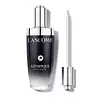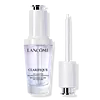What's inside
What's inside
 Key Ingredients
Key Ingredients

 Benefits
Benefits

 Concerns
Concerns

 Ingredients Side-by-side
Ingredients Side-by-side

Water
Skin ConditioningBifida Ferment Lysate
Skin ConditioningGlycerin
HumectantPentylene Glycol
Skin ConditioningPolymnia Sonchifolia Root Juice
Skin ConditioningDimethicone
EmollientAlpha-Glucan Oligosaccharide
CleansingSodium Carboxymethyl Beta-Glucan
CleansingSodium Hyaluronate
HumectantSalicyloyl Phytosphingosine
Skin ConditioningAdenosine
Skin ConditioningMannose
HumectantAmmonium Polyacryloyldimethyl Taurate
Emulsion StabilisingDipotassium Glycyrrhizate
HumectantHydroxyacetophenone
AntioxidantCaprylyl Glycol
EmollientTetrasodium Glutamate Diacetate
Citric Acid
BufferingLactic Acid
BufferingLactobacillus
Skin ConditioningAcetic Acid
BufferingMaltodextrin
AbsorbentXanthan Gum
EmulsifyingFaex Extract
Skin ConditioningOctyldodecanol
EmollientButylene Glycol
HumectantSodium Benzoate
MaskingParfum
MaskingWater, Bifida Ferment Lysate, Glycerin, Pentylene Glycol, Polymnia Sonchifolia Root Juice, Dimethicone, Alpha-Glucan Oligosaccharide, Sodium Carboxymethyl Beta-Glucan, Sodium Hyaluronate, Salicyloyl Phytosphingosine, Adenosine, Mannose, Ammonium Polyacryloyldimethyl Taurate, Dipotassium Glycyrrhizate, Hydroxyacetophenone, Caprylyl Glycol, Tetrasodium Glutamate Diacetate, Citric Acid, Lactic Acid, Lactobacillus, Acetic Acid, Maltodextrin, Xanthan Gum, Faex Extract, Octyldodecanol, Butylene Glycol, Sodium Benzoate, Parfum
Water
Skin ConditioningGluconolactone
Skin ConditioningNiacinamide
SmoothingButylene Glycol
HumectantPEG/PPG/Polybutylene Glycol-8/5/3 Glycerin
HumectantAlcohol Denat.
AntimicrobialPentylene Glycol
Skin ConditioningPotassium Hydroxide
BufferingMethyl Gluceth-20
HumectantTocopherol
AntioxidantHydroxyethylcellulose
Emulsion StabilisingSodium Hyaluronate
HumectantPPG-6-Decyltetradeceth-30
EmulsifyingFagus Sylvatica Bud Extract
TonicSalicylic Acid
MaskingChlorphenesin
AntimicrobialHelianthus Annuus Seed Oil
EmollientBenzoic Acid
MaskingSorbic Acid
PreservativeRosmarinus Officinalis Extract
AntimicrobialVitis Vinifera Seed Oil
EmollientPhytic Acid
Glycolic Acid
BufferingParfum
MaskingWater, Gluconolactone, Niacinamide, Butylene Glycol, PEG/PPG/Polybutylene Glycol-8/5/3 Glycerin, Alcohol Denat., Pentylene Glycol, Potassium Hydroxide, Methyl Gluceth-20, Tocopherol, Hydroxyethylcellulose, Sodium Hyaluronate, PPG-6-Decyltetradeceth-30, Fagus Sylvatica Bud Extract, Salicylic Acid, Chlorphenesin, Helianthus Annuus Seed Oil, Benzoic Acid, Sorbic Acid, Rosmarinus Officinalis Extract, Vitis Vinifera Seed Oil, Phytic Acid, Glycolic Acid, Parfum
 Reviews
Reviews

Ingredients Explained
These ingredients are found in both products.
Ingredients higher up in an ingredient list are typically present in a larger amount.
Butylene Glycol (or BG) is used within cosmetic products for a few different reasons:
Overall, Butylene Glycol is a safe and well-rounded ingredient that works well with other ingredients.
Though this ingredient works well with most skin types, some people with sensitive skin may experience a reaction such as allergic rashes, closed comedones, or itchiness.
Learn more about Butylene GlycolParfum is a catch-all term for an ingredient or more that is used to give a scent to products.
Also called "fragrance", this ingredient can be a blend of hundreds of chemicals or plant oils. This means every product with "fragrance" or "parfum" in the ingredients list is a different mixture.
For instance, Habanolide is a proprietary trade name for a specific aroma chemical. When used as a fragrance ingredient in cosmetics, most aroma chemicals fall under the broad labeling category of “FRAGRANCE” or “PARFUM” according to EU and US regulations.
The term 'parfum' or 'fragrance' is not regulated in many countries. In many cases, it is up to the brand to define this term.
For instance, many brands choose to label themselves as "fragrance-free" because they are not using synthetic fragrances. However, their products may still contain ingredients such as essential oils that are considered a fragrance by INCI standards.
One example is Calendula flower extract. Calendula is an essential oil that still imparts a scent or 'fragrance'.
Depending on the blend, the ingredients in the mixture can cause allergies and sensitivities on the skin. Some ingredients that are known EU allergens include linalool and citronellol.
Parfum can also be used to mask or cover an unpleasant scent.
The bottom line is: not all fragrances/parfum/ingredients are created equally. If you are worried about fragrances, we recommend taking a closer look at an ingredient. And of course, we always recommend speaking with a professional.
Learn more about ParfumPentylene glycol is typically used within a product to thicken it. It also adds a smooth, soft, and moisturizing feel to the product. It is naturally found in plants such as sugar beets.
The hydrophilic trait of Pentylene Glycol makes it a humectant. As a humectant, Pentylene Glycol helps draw moisture from the air to your skin. This can help keep your skin hydrated.
This property also makes Pentylene Glycol a great texture enhancer. It can also help thicken or stabilize a product.
Pentylene Glycol also acts as a mild preservative and helps to keep a product microbe-free.
Some people may experience mild eye and skin irritation from Pentylene Glycol. We always recommend speaking with a professional about using this ingredient in your routine.
Pentylene Glycol has a low molecular weight and is part of the 1,2-glycol family.
Learn more about Pentylene GlycolSodium Hyaluronate is hyaluronic acid's salt form. It is commonly derived from the sodium salt of hyaluronic acid.
Like hyaluronic acid, it is great at holding water and acts as a humectant. This makes it a great skin hydrating ingredient.
Sodium Hyaluronate is naturally occurring in our bodies and is mostly found in eye fluid and joints.
These are some other common types of Hyaluronic Acid:
Learn more about Sodium HyaluronateWater. It's the most common cosmetic ingredient of all. You'll usually see it at the top of ingredient lists, meaning that it makes up the largest part of the product.
So why is it so popular? Water most often acts as a solvent - this means that it helps dissolve other ingredients into the formulation.
You'll also recognize water as that liquid we all need to stay alive. If you see this, drink a glass of water. Stay hydrated!
Learn more about Water